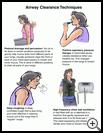
Airway Clearance Techniques
________________________________________________________________________
KEY POINTS
- Airway clearance techniques (ACTs) are ways to loosen thick, sticky mucus so it can be coughed up and cleared out of the lungs.
- Respiratory therapists have special training in lung and breathing problems. The therapist will help you and your child learn how to perform the techniques.
- When trying to loosen and cough up mucus, make sure that your child drinks enough liquids to stay well hydrated.
________________________________________________________________________
What are airway clearance techniques?
If your child has a lung disease such as cystic fibrosis (CF), your child may have a lot of mucus in the lungs. If the mucus builds up in your child’s airways, it can be hard to breathe. Excess mucus also makes it easier to get infections. Airway clearance techniques (ACTs) are ways to loosen thick, sticky mucus so it can be coughed up and cleared out of the lungs.
There are many airway clearance techniques. All forms of airway clearance therapy involve coughing. Most are easy to do. Your child’s healthcare provider will work with you to decide which are best for your child. Your provider will probably refer to you a respiratory therapist. Respiratory therapists have special training in lung and breathing problems. The therapist will help you and your child learn how to perform the techniques.
Some of these techniques your child can learn to do, and some require special equipment or a trained person to help. The techniques that your child can usually perform alone include:
- Deep coughing is a deep, controlled cough. A deep cough is less tiring and more effective in clearing mucus out of the lungs than a “regular” cough.
- Huff coughing is when your child takes a breath that is a little deeper than normal, then blows the air out like “huffing” onto a mirror or window to steam it up. It is not as forceful as a cough but can work better and be less tiring.
- Self drainage or autogenic drainage (AD) is learning to breath 3 different ways to move mucus out of the lungs. Learning to perform it correctly takes some training and practice. It works best for people over 8 years old.
- Active cycle of breathing therapy (ACBT) combines gentle breathing, deep breathing, and huff coughs. Your child performs these different kinds of breathing in cycles to loosen and move mucus out of the lungs.
- Physical activity can be another good way to help bring up mucus in the lungs. Also, regular physical activity helps your child’s muscles do more work with less oxygen.
Techniques that require equipment or another person to help your child include:
- Postural drainage and percussion. For this technique, your child lies down in certain positions (postures) so that gravity can help mucus drain from different parts of the lungs. You or a therapist claps your child’s chest, which is called percussion, to loosen and move mucus. This is done in different positions to drain all parts of your child’s lungs.
- Positive expiratory pressure therapy (PEP). This therapy uses a hand-held device that creates resistance when your child breathes out. This changes pressure in the lungs to loosen mucus.
- Oscillating positive expiratory pressure or flutter PEP. This technique also uses a handheld device to create resistance when your child breathes out. The device flutters or vibrates the airways to loosen mucus.
- High-frequency chest wall oscillation. For this technique, your child wears an inflatable vest that is attached to a machine. The vest gently squeezes and releases from 5 to 20 times per second. This rapid squeezing and releasing helps to vibrate your child’s chest to loosen mucus. This technique may be used with huff cough or with a nebulizer.
The best airway clearance therapy is the one that helps your child clear the most mucus, and the one you and your child are most likely to do every day as part of your child’s treatments. Ask your child’s healthcare provider what techniques or exercises will work best for your child.
When trying to loosen and cough up mucus, make sure that your child drinks enough liquids to stay well hydrated. If your child is not getting enough liquids, the mucus will be stickier and harder to cough up. Ask your child’s healthcare provider how much your child should drink each day. Your child’s provider may also recommend medicine to help keep mucus thin and easier to cough up. ACTs are often used with other treatments, such as inhaled medicines (bronchodilators).
For more information, contact:
- National Heart, Lung, and Blood Institute
https://www.nhlbi.nih.gov/health-topics/cystic-fibrosis - Cystic Fibrosis Foundation
https://www.cff.org/
Last modified: 2021-06-25
Last reviewed: 2021-06-17

